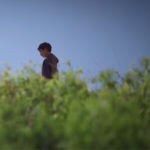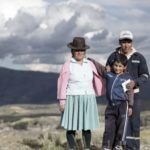A school in the Andes writes a new history of Peru
Qasanqay is a small village 3,800 meters above sea level in the heart of the Andes, in Ayacucho. The country's Independence was signed in this Peruvian region in 1826; this is also where Sendero Luminoso originated, the terrorist group that triggered the savage violence in the 1980s against the poorest population and law enforcement agencies. Over 69,000 Peruvians died.

The people in Qasanqay rely on small-scale agriculture for their livelihood. Rosel Quispe is 9 years old and is the son of a couple of peasants who survive by sowing native potatoes and other tubers. The father, Edgar Quispe, speaks some Spanish; the mother, Ida Flores, only speaks Quechua. Despite the fact that the images of the past and the present seem like a postcard of the future -because very little has changed in the last 100 years- things are happening in the village school that could mark a new fate for the local children.
“Several children at the school already understand what they read”, says fourth grade teacher, Marciana Sosa, Rosel's teacher, proudly. A fact that would seem common in many countries around the world, but which in Peru is an expression of hope: only three out of ten Peruvian schoolchildren understand what they read, according to official figures of the Ministry of Education; moreover, the country ranks penultimate in the PISA reading comprehension test.
However, in Qasanqay the students have shown remarkable progress compared with the national average. The reason is the application of the “Leer es estar adelante” (Reading means keeping ahead) program that the BBVA Continental Foundation has implemented for 9 years at over 950 schools in Peru. Perhaps the most relevant figure is the one that shows that 6 out of 10 children served by the program have improved their reading comprehension, twice the national average.
After discovering the world beyond the horizon that Rosel sees every day thanks to reading, the young student says that he wants to be a teacher when he is older. And he has started his educational work with his parents, teaching them to read the texts of “Adelante” (Forward), the books that are part of the reading comprehension program, which also envisages training for teachers.

Rosel with his family.
“Children who understand what they read can realize all their dreams, they grow older
Rosel is one of the more than 110,000 children who have improved their reading comprehension and now have the chance to access a better future, because reading and its comprehension are essential for development, both personal and professional. “Children who understand what they read can realize all their dreams, they grow older”, says the teacher Marciana.
The Foundation shares the teacher's view, the purpose that BBVA is furthering around the world becomes a reality through education: to bring the age of opportunity to everyone. These opportunities will also be available to Rosel and many other children like him.
To find out more about the BBVA Continental Foundation, click on www.fundacionbbva.pe.
A country that thinks the right way
The Foundation is convinced that education and culture are the twin sisters that instill the essential values for a society to live in an atmosphere of respect, tolerance and solidarity. A life among human beings devoid of these features leads to the violence that in turn leads to backwardness and poverty. This is why since its creation in 1973, the Foundation is immersed in a sustained effort to promote access to education and art. Cultivated and educated people are citizens who think the right way, who take decisions for their well-being without harming their neighbors.
Despite this reflection, the Foundation has made the motto “Let's think the right way” a prelude for the unavoidable individual and social action to help Peru become a country where all citizens have the chance to access the opportunities afforded by modern times.
In the artistic area, the institution has become one of the main advocates of art in various expressions. In recent years, it has focused on helping theater grow and strengthen. The main reason is that through theater people can face situations in their real life, generating the necessary empathy to help understand and tolerate new or unknown situations.
In the academic field, the Foundation grants scholarships to talented young people whose economic situation could endanger their development. This is the case of Roger Márquez, a descendent of the shipibo conibo ethnic group in the Peruvian forest, who almost had to leave his studies at the School of Art of Pontificia Universidad Católica del Perú due to serious economic difficulties. Thanks to his excellent grades he could access the scholarship that the BBVA Continental Foundation grants through the university's social assistance office.
Another praiseworthy activity carried out by the BBVA Continental Foundation is the preservation of the country's architectural cultural heritage. This activity is carried out through the conservation of large colonial houses that have witnessed the country's transformation throughout history. These buildings, which are practically in their original state, such as the historical House of Independence in Trujillo, where one of the first pro-independence proclamations was pronounced in the 19th century, are part of the intense cultural activity carried out in its cities.
The same can be said of the plots rescued from the past in the cities of Cusco and Arequipa. In the imperial city, Casa Cabrera houses the Pre-Columbian Art Museum (MAP), while the White City can boast Casa Tristán del Pozo, the headquarters of the Pedro Brescia Cafferata Gallery, which houses the artistic work of the most representative names of Arequipa painting.
All these activities have the valuable backing provided by the social media. Thanks to its work in recent years, the Foundation has developed a platform on Facebook that now has over 210,000 followers, becoming the most successful cultural social network in Peru.